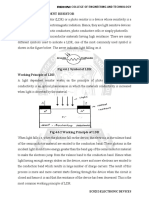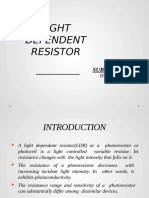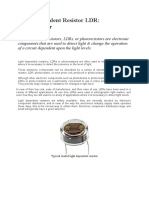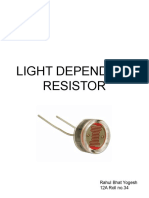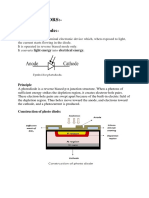LDR-Light Dependent Resistor
LDR-Light Dependent Resistor
Uploaded by
santoshiCopyright:
Available Formats
LDR-Light Dependent Resistor
LDR-Light Dependent Resistor
Uploaded by
santoshiOriginal Title
Copyright
Available Formats
Share this document
Did you find this document useful?
Is this content inappropriate?
Copyright:
Available Formats
LDR-Light Dependent Resistor
LDR-Light Dependent Resistor
Uploaded by
santoshiCopyright:
Available Formats
LDR- Light Dependent Resistor
LDRs or Light Dependent Resistors are very useful especially in light/dark sensor circuits. Light
Dependent Resistor or Photoresistor is a passive electronic component, basically a resistor which
has a resistance that varies depending on the light intensity.
Characteristics of LDR
LDRs are light dependent devices whose resistance is decreased when light falls on them and
that is increased in the dark. When a light dependent resistor is kept in dark, its resistance is very
high. This resistance is called as dark resistance. It can be as high as 1012 and if the device is
allowed to absorb light its resistance will be decreased drastically. If a constant voltage is applied
to it and intensity of light is increased the current starts increasing. Figure below shows
resistance vs. illumination curve for a particular LDR.
Photocells or LDRs are non linear
devices. There sensitivity varies with the wavelength of light incident on them. Some photocells
might not at all response to a certain range of wavelengths. Based on the material used different
cells have different spectral response curves.
The structure of a light dependent resistor consists of a light sensitive material which is deposited
on an insulating substrate such as ceramic. The material is deposited in zigzag pattern in order to
obtain the desired resistance and power rating. This zigzag area separates the metal deposited
areas into two regions. Then the ohmic contacts are made on the either sides of the area. The
resistances of these contacts should be as less as possible to make sure that the resistance mainly
changes due to the effect of light only.
Applications of LDR
LDRs have low cost and simple structure.
They are often used as light sensors.
They are used when there is a need to detect absences or presences of light like in a
camera light meter.
Used in street lamps, alarm clock, burglar alarm circuits, light intensity meters, for
counting the packages moving on a conveyor belt, etc.
You might also like
- LDR Project PresentationDocument16 pagesLDR Project PresentationIndra Devi100% (1)
- Photo ResistorDocument6 pagesPhoto Resistorsnehashissaha66No ratings yet
- What Is A Light Dependent Resistor or A Photo Resistor?: ResistivityDocument4 pagesWhat Is A Light Dependent Resistor or A Photo Resistor?: Resistivitymani_vlsiNo ratings yet
- Light Dependent ResistorDocument7 pagesLight Dependent ResistorRUPALI MANKARNo ratings yet
- Light Dependent ResistorDocument4 pagesLight Dependent ResistorShailesh RanawareNo ratings yet
- Physics ProjectDocument13 pagesPhysics ProjectPiyush ShahNo ratings yet
- Light Dependent ResistorDocument4 pagesLight Dependent ResistorhasnaNo ratings yet
- LDR SensorDocument5 pagesLDR SensorSV TechnologiesNo ratings yet
- Rohini 73227582967Document3 pagesRohini 73227582967MohammedNo ratings yet
- LDR and ApplicationDocument4 pagesLDR and Applicationm40sujithreddyNo ratings yet
- Physics ProjectDocument17 pagesPhysics Projectmokshpatel82007No ratings yet
- Light Dependent Resistor LDRDocument5 pagesLight Dependent Resistor LDRAkshat GoelNo ratings yet
- Light Dependant ResisterDocument10 pagesLight Dependant ResisterAyush PattnaikNo ratings yet
- LDR Properties: The LDR Resistance Decreases With Increasing Light IntensityDocument11 pagesLDR Properties: The LDR Resistance Decreases With Increasing Light IntensityJr AndysNo ratings yet
- Types of Light Dependent Resistors:: ObjectiveDocument4 pagesTypes of Light Dependent Resistors:: ObjectiveShahzaib Anwar OffNo ratings yet
- Tanay LDR ProjectDocument4 pagesTanay LDR ProjectTanay SharmaNo ratings yet
- Light Dependent ResistanceDocument5 pagesLight Dependent ResistanceTanay SharmaNo ratings yet
- LDRDocument7 pagesLDRJanel DianelaNo ratings yet
- Physics ProjectDocument13 pagesPhysics Projectdivijkhare11No ratings yet
- LDR Sensor Physics class-12Document16 pagesLDR Sensor Physics class-12shubhamgaur6433No ratings yet
- Physics ProjectDocument9 pagesPhysics ProjectAshok KumarNo ratings yet
- Bhai Vaibhav AajanaDocument23 pagesBhai Vaibhav AajanaNikhil KushwahNo ratings yet
- Material On LDR (A - S) : PhotoresistorDocument2 pagesMaterial On LDR (A - S) : PhotoresistorThinesh KumarNo ratings yet
- Ec8252-Electronic Devices: Jothibasu M Ap (SR - GR) /ece PsgitechDocument27 pagesEc8252-Electronic Devices: Jothibasu M Ap (SR - GR) /ece PsgitechJothibasu MarappanNo ratings yet
- Phy ProjDocument16 pagesPhy ProjpranavtsababayagaNo ratings yet
- Mahalashmi Vidhya Mandhir Avadi: Light Dependent ResisterDocument25 pagesMahalashmi Vidhya Mandhir Avadi: Light Dependent Resisterkarthik srinivasanNo ratings yet
- LDR Current VariationDocument23 pagesLDR Current Variationaniq amin100% (2)
- Physics ProjectDocument8 pagesPhysics ProjectRaghhav MalaniNo ratings yet
- LDR Current VariationDocument22 pagesLDR Current Variationaniq aminNo ratings yet
- Physics Investi Gatory ProjectDocument10 pagesPhysics Investi Gatory Projectsoumya.sj09No ratings yet
- Sensor Orp12Document4 pagesSensor Orp12chandialucasNo ratings yet
- Led Investigatroy ProjectDocument29 pagesLed Investigatroy ProjectkeerthivasanNo ratings yet
- Dark Sensor Light Based On LDRDocument17 pagesDark Sensor Light Based On LDRhafsaNo ratings yet
- Photo ResistorsDocument20 pagesPhoto ResistorsRashmi ChaturvediNo ratings yet
- What Is An LDR?Document3 pagesWhat Is An LDR?Bhartendu SharmaNo ratings yet
- LDR and RelayDocument4 pagesLDR and RelayApurvNo ratings yet
- Physics ProjectDocument18 pagesPhysics ProjectSADEADO ROASTSNo ratings yet
- Photo Resistor:-: Uses For Light Dependent ResistorsDocument1 pagePhoto Resistor:-: Uses For Light Dependent Resistorsvvk88No ratings yet
- What Is LDRDocument5 pagesWhat Is LDRPrAkhar VermaNo ratings yet
- Resistor. It Is A Type of Semiconductor andDocument18 pagesResistor. It Is A Type of Semiconductor andjrajaNo ratings yet
- What Is Light Dependent ResistorDocument1 pageWhat Is Light Dependent ResistormirazNo ratings yet
- To Study Variation of Current Using A LDR - Physics Astronomy Project TopicsDocument7 pagesTo Study Variation of Current Using A LDR - Physics Astronomy Project Topicsashamishra01981No ratings yet
- Split 1Document15 pagesSplit 1bk4843057No ratings yet
- Sensors - FinalDocument13 pagesSensors - Finalbob123No ratings yet
- Light-Dependent-Resistors-A-Comprehensive-Overview (1)Document9 pagesLight-Dependent-Resistors-A-Comprehensive-Overview (1)dasherking69No ratings yet
- Rishi Physics InvestigatoryDocument15 pagesRishi Physics Investigatoryjaxib70508No ratings yet
- INVESTIGATORY PHYSICS PROJECT Class 12Document30 pagesINVESTIGATORY PHYSICS PROJECT Class 12supratimsinha181No ratings yet
- My Physics ProjectDocument25 pagesMy Physics ProjectShubham SmarthNo ratings yet
- Phy IPDocument13 pagesPhy IPJerin JacobNo ratings yet
- Light Sensor Including Photocell and LDR SensorDocument11 pagesLight Sensor Including Photocell and LDR SensorKhairiBudayawanNo ratings yet
- Variation of Current Through An LDRDocument16 pagesVariation of Current Through An LDRSubiksha Ravi100% (4)
- 2.2 Light Depending Resistor: Fig.2.2 LDRDocument1 page2.2 Light Depending Resistor: Fig.2.2 LDRSiji VargheseNo ratings yet
- Physics Project 2Document15 pagesPhysics Project 2rakeshsahu9301No ratings yet
- Physics ProjectDocument13 pagesPhysics ProjectAadi AthreyaNo ratings yet
- Automatic Light ControlDocument43 pagesAutomatic Light Controlpushkarlhr1985No ratings yet
- Physics Investigatory Project LIGHT DEPEDocument15 pagesPhysics Investigatory Project LIGHT DEPEJerin JacobNo ratings yet
- 59.intensity Measurement Using LDRDocument3 pages59.intensity Measurement Using LDRKathir VelNo ratings yet
- UntitledDocument3 pagesUntitledkavinrajesh197No ratings yet
- LDRDocument2 pagesLDRBhaskar Rao PNo ratings yet








